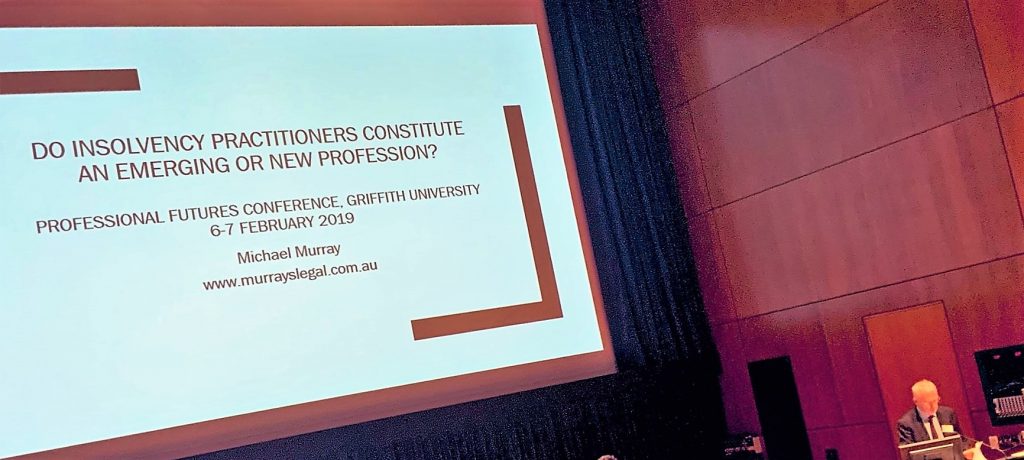I was pleased to have given a presentation on the future of the insolvency profession, at Griffith University’s excellent Professional Futures Conference on 6-7 February 2019. This is my brief account, with some questions about professionalism following.
My talk examined whether insolvency was in fact a profession, or an emerging one, or an industry. The criteria for a group being a profession, and the significance of that, are well documented, importantly including a primary focus on the public interest rather than commercial or self-interest.
The History
As the history shows, the history of the tussle between lawyers and accountants in the 19th century for the work coming out of the rise and fall of large companies was dominated by self-interest. The accountants’ focus on financial accounts saw them ‘win’, though perhaps also because lawyers saw insolvency as ‘distasteful’, thereby allowing the accountants to shape the wide discretions they have in insolvency to this day, and, some have said, subverted the law.
Deloitte and PWC had their origins at that time.
As in New Zealand today, UK accountants did not need to be licensed to practise in insolvency until the 1986 UK Insolvency Act. This coincided with Thatcherism and the ‘privatisation’ of insolvency, which Australia now embraces more so than the UK, and NZ; and the influence of the UK professional bodies in response to the reforms served to allow them their significant co-regulation role, only now being reviewed. At the same time, the inner circle shut out many accountants who had practised in the field.
This period has been said to have been the real start of UK’s insolvency profession.
Australia
The profession in Australia as a cohesive group is even more recent, following the 1988 Harmer report, and the first edition of Keay’s Insolvency, in 1993.
Its 2008 Code, instigated by CEO Mike Lotzof, and prompted by then Justice Robert Austin, was a significant point from which the profession has progressed. But its quality education and its technical expertise may be discounted by its present fracturing, limited co-regulation and low capacity to influence. Dr Jenny Dickfos’ paper at the conference on the limited take-up by IP firms on information technology is another indicator.
Issues of funding of the profession, and the lack of clarity between practitioners’ public and private duties, continue.
Insolvency is still classified as ‘emerging’ rather than having arrived. Respected opinion in the UK supports that assessment there.
Auditors
Professor Chris Symes (Adelaide) gave another slant, and linked insolvency with the auditing profession, asking whether its annual involvement may take a stronger role in relation to business instability, and foreshadowing the impact of AI on both professions –‘quicker, few physical staff and offices required’. The declining numbers in both disciplines which he displayed may be a sign.
Boundaries crossed
The conference adopted an excellent and fruitful approach requiring each of the participants to look at their respective areas of interest from an overall ‘professional’ perspective, with the common traits of professionalism in medicine, engineering, nursing, architecture and law feeding into the groups’ thinking. Independence, for example, is a significant issue in many professions, as are public interest issues, and the role of the professional bodies.
Griffith University
Thank you to Griffith University in holding this conference and, from my perspective, thanks in particular to Professors Charles Sampford, Brett Freudenberg and John Flood, not discounting the many others involved and attending.
Questions?
The learnings from the conference have prompted me to set out a series of questions about professionalism.
Stay tuned.



